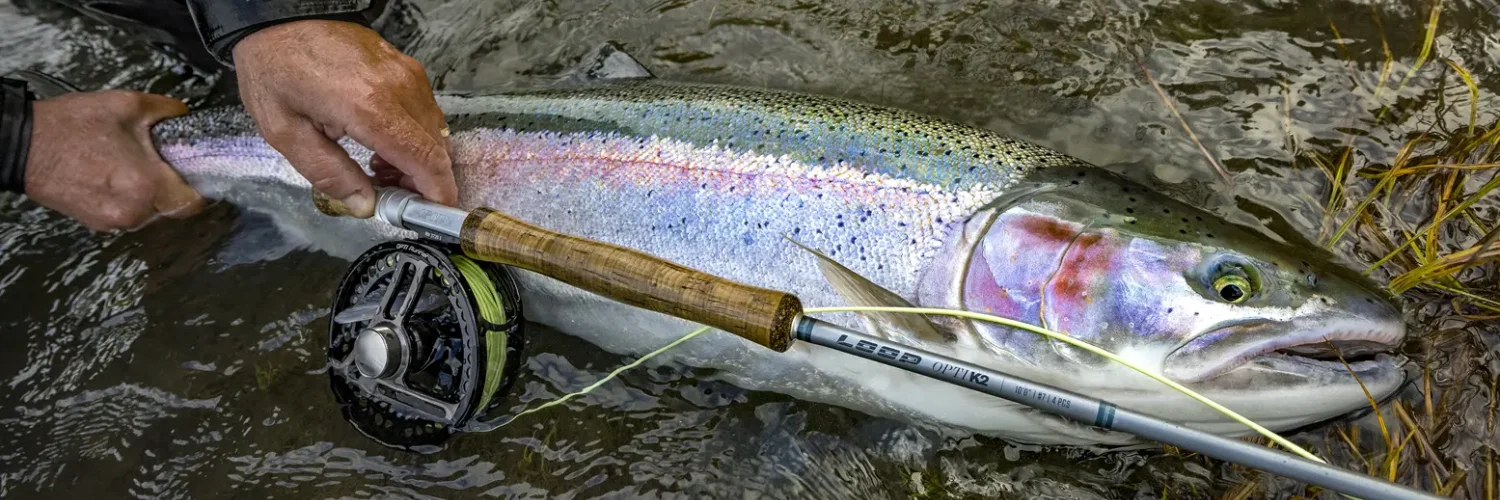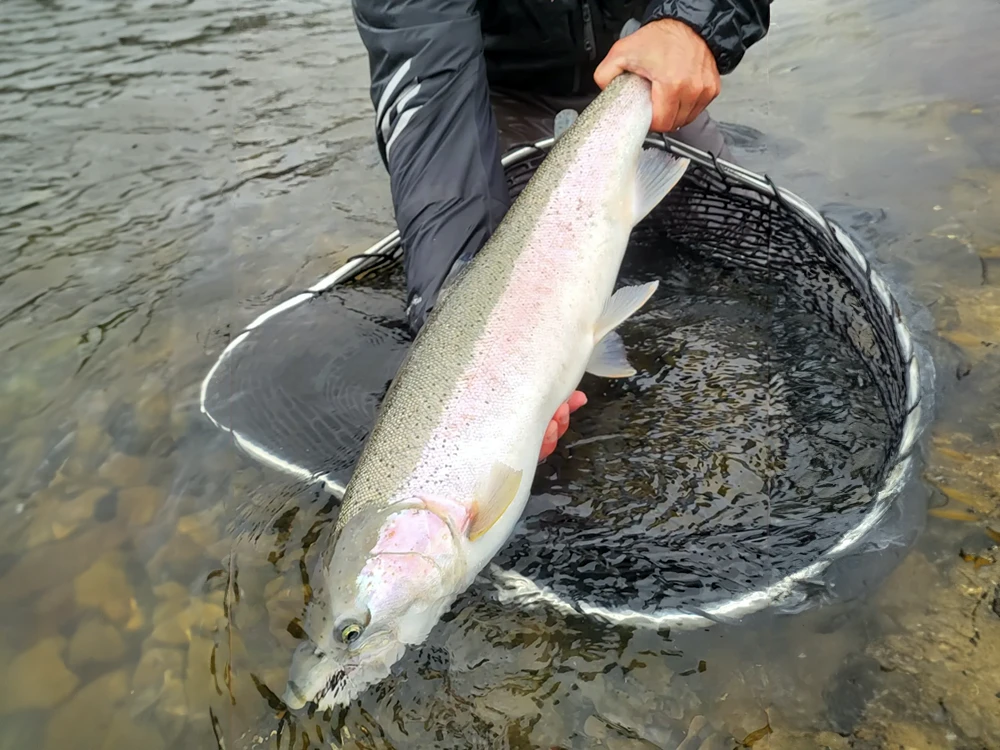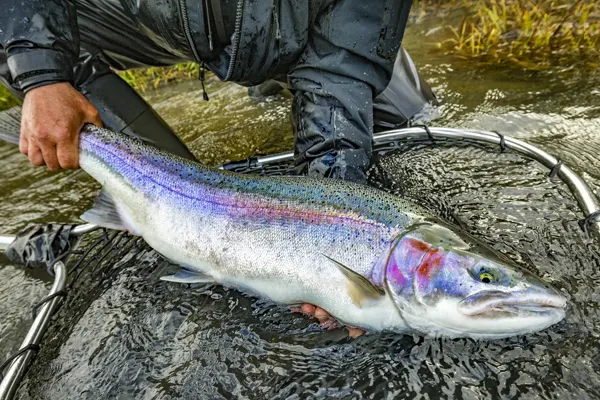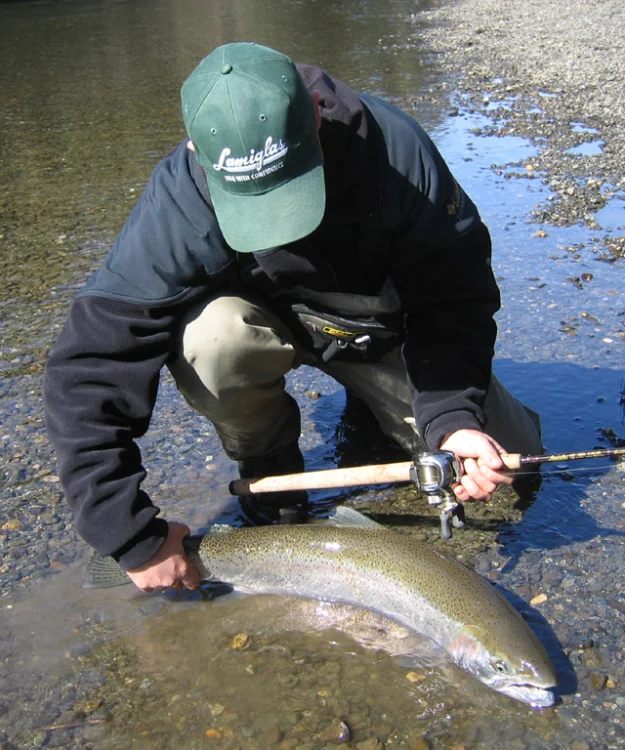
Kasilof River Steelhead Fishing Trips

Our Kasilof River steelhead fishing trips run from early September through November. We offer both full- and half-day charters, with a focus on quality over quantity—limiting trips to two anglers per boat, three at most. While fly fishing is the preferred method for these trips, we also offer spinning gear for those who prefer it.
All steelhead fishing on the Kasilof is strictly catch and release. The Kasilof River receives a strong annual return of fall-run steelhead. These anadromous rainbow trout begin arriving in mid to late August, with peak numbers typically occurring from September through November.
Kasilof Steelhead Run Timing:
We begin to see the first Kasiof steelhead while fishing for silver salmon in August and early September. By mid to late September the silver run decreases significantly and the number of newly arriving Kasilof Steelhead increases considerably.
Peak timing for this return normally occurs in the month of October although fresh fish continue entering the river into the month of November. As with all steelhead fishing, anglers should prepare for rainy and cold weather.
Where We Fish For Kasilof Steelhead
We target Kasilof steelhead from the outlet of Tustumena Lake down to the Sterling Highway Bridge. This stretch offers the most water to cover, which is essential in this fishery.
The Kasilof is a large river in the fall, and steelhead tend to hold in select concentrations throughout the system.
As with all quality steelhead fisheries, success here requires patience, precision, and refined technique. But when it all comes together, the reward is worth it—these ocean-fresh fish are powerful fighters, especially in the cold, glacial-fed waters of the Kasilof.
Kasilof Steelhead Fishing Rates
September/October/November
Kasilof Half Day – $295pp
Up to 5 hours
Kasilof Full Day – $350pp
Up to 8 hours
Things To Know About Kasilof River Steelhead:
*Spawning Season & Conditions: Spawning begins in early spring as water temperatures rise (daily temperatures around 42–46°f).
*Habitat: Maturing adults seek out shallow gravel riffles or clear streams suitable for nesting.
*Nest Preparation: The female uses her tail to dig a redd (nest) about 4–12 inches deep and 10–15 inches wide.
*Egg Numbers: Between 200 and 8,000 eggs can be deposited in a redd. The eggs are fertilized by the male’s milt and then covered with gravel.
*Hatching & Emergence: Hatching occurs anywhere from a few weeks to four months after spawning (depending on water temperature), with fry emerging a few weeks later after absorbing their yolk sacs.
*Age, Growth, and Maturity: Genetics, food availability, water temperature, population density, and habitat productivity all influence growth and the onset of sexual maturity. Steelhead generally spend about 3 years in freshwater before migrating to the ocean, followed by an additional 2 years at sea before returning to spawn. Steelhead exhibit significant variability; some return after just one year at sea, while others may spend up to 4 years.
*Return Periods: Kasilof Steelhead are considered Fall-run: they enter freshwater from August through October (and sometimes even through winter), though spawning still occurs in the spring when temperatures are optimal.
*Early Life: Upon emerging, the fry form schools along stream margins or sheltered lake shores. Initially, they feed on small crustaceans, plant material, and various aquatic insects (and their larvae).
*Freshwater to Ocean Transition: Juvenile steelhead begin their migration (smolting) to saltwater from late April through mid-June.
*Ocean Phase: Once in the ocean, steelhead grow quickly due to plentiful food sources. They can travel hundreds of miles into open waters before returning to their natal streams. Detailed patterns of ocean migration remain less well-documented.
How We Fish for Kasilof River Steelhead
We primarily target Kasilof steelhead with fly rods—both single-hand and spey setups—but spinning tackle is available for those who prefer it. These fish time their fall migration to coincide with the silver salmon spawn and often feed on loose salmon eggs.
Single egg patterns or beads are highly effective, and we typically dead-drift them under a strike indicator with a fly rod or beneath a float with spinning gear.
In addition to egg presentations, Kasilof steelhead will aggressively strike swung flies, such as intruder patterns, making both single-hand and spey rod tactics exciting and productive options.
Kasilof Steelhead Limits
Kasilof Steelhead are entirely catch and release.
FAQ’s About Steelhead Fishing
Where is the best steelhead fishing in Alaska?
Where to fish on the Kasilof River?
When to fish for steelhead in Alaska?
Can you keep king salmon in Kasilof River?
Online Booking Options
More Information on Kasilof River Salmon Fishing
In a year that saw record sockeye returns to the Kenai River, the Kasilof River delivered an equally impressive showing. By August 9, a total of 1,197,471 sockeye had passed the sonar at river mile 8, surpassing the previous record of 971,604 set in 2022. Peak run timing occurred between June 30 and July 26, …
The triannual Board of Fisheries meeting for upper Cook Inlet took place in early February in Anchorage and the seven member board, many selected by newly elected governor Mike Dunleavy, voted in favor of several proposals that shifted fish away from commercial fisheries and into the rivers. As the economic value of the fish has …
There is certainly no doubt the Kenai is the world’s most famous salmon river, home to the largest kings on earth and the place of piscatorial dreams. Yet just 20 minutes down the Sterling highway is the Kasilof, a river slightly smaller than the Kenai, but equally rich in historic angling lore and yes, huge …
The 2018 season is well underway and just like every season it has exhibited its own unique personality. Perhaps the most noteworthy characteristic to the season has been the lack of warm weather, especially in mid to late May with temps still dipping into the thirties overnight and struggling to break into the sixties during the …
Early Run Kasilof Kings! Low water and fresh fish makes for some great action. If you are looking for that first fresh salmon of the season, look no further than the Kasilof in late May and early June. After a long winter in Alaska, there is just something special about the first salmon returning to …
Kasilof Sockeye: Drift below Tustumena Lake offers solitude and good numbers of sockeye salmon. Changes in our king salmon fisheries have led us to further diversify and look for additional and exciting new fishing trips. One of these is the float from Tustumena Lake on the Kasilof River down to the Sterling Highway Bridge. Sockeye salmon migration …




